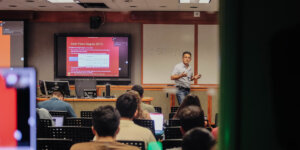
Innovation in Engineering and Design for Global Crises in Alaska
If you’ve ever had the pleasure of watching the sun rise over a smog-filled Los Angeles, you might think our air quality is the worst in the country. Guess again. Try Fairbanks, Alaska, population 30,000. Named in 2018 as “the most polluted city in the nation,” Fairbanks is miles away from major city centers, yet boasts a cloud of smoke that could put huge metropolises to shame.
The culprit? Wood burning stoves.
This smoke caught the attention of an interdisciplinary team of USC students, who are working on solutions to cold-climate sustainability issues. They’ve come up with schematics for a “Chimney Cherry” that filters out smoke particulates, resulting in a cleaner burn — a literal smoke screen.
The project is part of the Innovation in Engineering and Design for Global Crises curriculum, which boasts a wide range of students from different USC schools, despite being a civil engineering course. One student on the team, Serena Allen, is a USC Price public policy major with an interest in sustainability technology.
“It’s technically a civil engineering class, but it has people from majors all over,” Allen said. “It’s really on sustainability in cold weather.”
The Chimney Cherry team consists of six students: three USC Viterbi engineers and three students from different schools across USC.
“This class is focused on solving particularly Alaskan problems,” said Ben Brooks, a USC Viterbi student in computer science and electrical engineering on the team. While the broader focus is on cold weather sustainability, Fairbanks presents a unique problem because of how prevalent wood-burning stoves are in the area.
“When you burn wood or coal, there’s this incomplete combustion that happens,” Brooks said. “You get these tiny particulate emissions that will go up into the atmosphere, and if you breathe them in, they can pass through the blood barrier and give you all kinds of negative health effects.”
The pollution is so prevalent that 25% of infants in wood-burning regions are hospitalized, compared to a 5% national average, according to Allen.
“Fairbanks is the most polluted city in the country,” Brooks explained. “It sits in a bowl very similar to Los Angeles, where inversions pop up in the winter — when the temperature gets super cold, the hot air sits in this cup surrounded by mountains, and the pollution never actually leaves the local atmosphere.”
The team travelled to Alaska under the impression that around 20% of the pollution in the atmosphere was caused by wood stoves. When they arrived, they found that it was closer to 40-60%, and in some localities it reached 80%.
Why not switch to gas or electric? For Fairbanks residents, it’s not that simple. The alternatives are considerably more expensive, and the median income in the city is only $30,000 a year. Gas can run up to $3,000 annually, which is no small price to pay. Not using these stoves isn’t an option, especially in an area where the temperature can reach staggering lows.
“You have these very cold winter months, where you’re getting -20, -30 degrees,” Allen said. “Everyone is burning wood just to stay alive, and it can make it so smoggy you can’t even see across a football field.”
The Environmental Protection Agency is cracking down on the borough of Fairbanks for not meeting air quality requirements, despite any real solutions in sight. This means pulling federal funding until the air gets better, which could make the situation even worse.
The local government, the Northstar Bureau, tried to reduce the amount of wood stoves actively burning in an initiative called a “wood stove change-up.” They promised to subsidize homes to switch from wood stoves to alternatives like gas or electric, albeit more expensive ones. According to Brooks, it hasn’t seen much traction.
“The state motto of Alaska is the ‘last frontier,’” said Brooks. “There’s a lot of open land, and an opportunity to live off of this open land. There’s also a lot of people who don’t want the government interacting with them.”
Additionally, Allen added, power outages are common in the area. This year alone, there’s been at least nine power outages.
Enter the Chimney Cherry, a self-contained device that can be applied right to the chimney without external assistance or invasive renovations. Using the combination of a smoke precipitator and a thermoelectric generator, the Chimney Cherry electrically charges the smoke particles so that they stick to the sides of the chimney instead of entering into the atmosphere. The technology is already common on the industrial scale, according to Brooks, but hasn’t yet seen much use on the consumer market.
“There are these tiny particulates that are uncharged, and so we generate an electrical field at the top of the chimney,” said Brooks. “Electrons get shot out of something called an electrode sticking down the chimney, charging the particulates, and then they settle on the sides of the chimney without actually exiting it. You basically clean your chimney and get all the particulates that would have entered the atmosphere.”
Both Brooks and Allen emphasized the non-invasive nature of the technology, which doesn’t need a third party to install or additional power in order to function.
“What we’re trying to do is build something that we can put on top of people’s stoves without ever opening their door and entering the house, drilling holes in the roof, plugging into their power,” Brooks said. “Basically, something that runs completely by itself, completely renewably, and people can burn how they want without the government involved.”
While applications aren’t quite yet underway, the team is optimistic about their schematics, including expanding and modifying it for different markets, such as replacing the thermoelectric generator with solar panels for warmer climates. They also received fellowship funding from the Blackstone Launchpad and plan to feature their work in the Min Family Social Entrepreneurship Challenge in May. Going forward, the applications of the Chimney Cherry could extend well beyond just Fairbanks.
“In other developing countries, a million people die a year just from burning wood inside their homes to cook,” Allen explained. “We might be able to help people maintain these lifestyles, when there’s not a lot of other options. It’s really this empowerment of people continuing to live how they want to live, without the negative consequences.”
Published on April 20th, 2022
Last updated on April 20th, 2022











